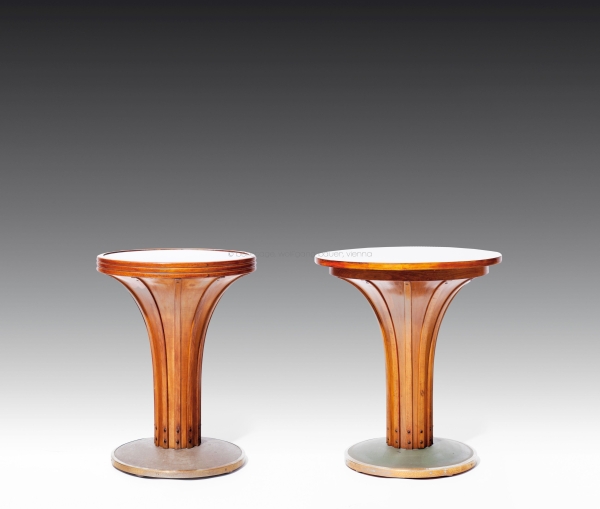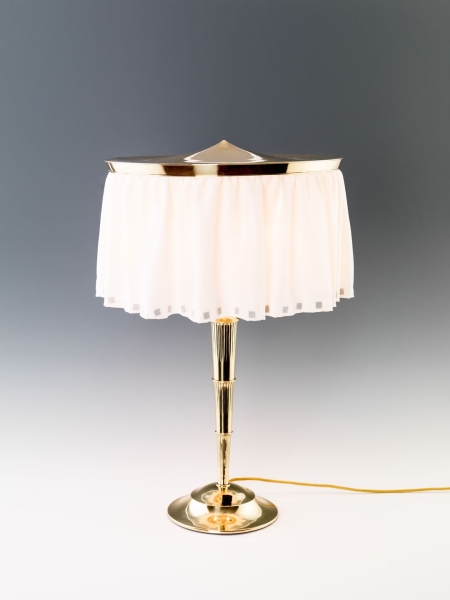The success story of the Thonet furniture company dates back to 1819, when master cabinetmaker Michael Thonet opened a furniture manufacturing business in his home town of Boppard am Rhein. In 1830, Thonet began experimenting with new techniques for bending wood. He cut the veneer sheets into strips in the grain direction of the wood, boiled them in glue, pressed them together and bent them into the desired shape. The result was light and elegant bentwood furniture at relatively low prices, which required less labor and materials than conventional methods.
[...] Despite the innovative idea, financial success failed to materialize due to a lack of sales opportunities in the small region.
Michael Thonet went to Vienna in 1842, where he was soon granted the privilege of "bending any type of wood, even the most brittle, into any shape and form by chemical-mechanical means" and was given the opportunity to work together with the furniture manufacturer Carl Leistler in the Liechtenstein City Palace. In 1849, Thonet set up his own business with his four sons and founded a company at Gumpendorfer Hauptstraße 396 in Vienna VI. [...] In 1852, a store was opened in the Montenuovo Palace at Strauchgasse 247-248 in Vienna I. In 1853, the business was relocated to the Mollardmühle at Mollardgasse 173 in Vienna VI with 42 employees.
In 1856, due to the limited space available and the increased demand for wood as a raw material, the decision was made to move production from Mollardgasse in Vienna to Koritschan (Korycany) in Moravia, where production finally began in 1857, resulting in design classics such as armchair no. 14 (1859). In 1858, the business in Mollardgasse and the store in Strauchgasse were closed and a new sales branch was set up in the Thonets' home at Jägerzeile 26 (now Praterstraße) in Vienna II. From this point on, Vienna functioned solely as a sales center. Over the decades, the company expanded into other factories in line with its commercial success. Following its great success at the London World's Fair in 1862, another store was opened at 16 Ludgate Hill in London. After the patent expired in 1856, the Thonet brothers were confronted by rival companies such as Jacob & Josef Kohn from 1869. In 1875/1876, a prestigious residential and commercial building was built at Kärntnerstraße 12 in Vienna I and in 1883 a department store at Brandstätte 2 on Stephansplatz in Vienna 1, which was destroyed by bombs in 1945.
At the turn of the century, management passed to the next generation of Thonets. In 1922, the company was taken over by Mundus AG, founded by Jewish businessman Leopold Pilzer in 1907, to which Jacob & Josef Kohn had also belonged since 1914. After economic downturns during the First World War, Thonet Mundus AG was able to re-establish itself on the international market under Pilzer's management through strategic measures such as the reduction of the product range and the sale of innovative tubular steel furniture. After the annexation of Austria by the German Reich, Pilzer agreed a share swap with the Thonet family before emigrating to the USA. Pilzer retained the rights for America, England and France, the Thonet family for Austria and Germany.
After the end of the Second World War, the former global corporation was divided into several individual companies, including Thonet Industries in the USA, Thonet Frères in France, Thonet Frankenberg in Germany and Thonet Vienna. [...] The Thonet brothers embodied timeless furniture design and the aesthetic interplay of form and function like hardly any other furniture company in the Danube Monarchy. Through the congenial combination of the further development of their wood bending technology for industrial series production, their progressive business strategies and their involvement of modern architects such as Otto Wagner, Otto Prutscher, Josef Frank, Ludwig Mies van der Rohe, Le Corbusier and Marcel Breuer as designers, they became one of the most innovative and modern furniture manufacturers in the world. The company, which employed around 6,000 people around 1900, had sales offices in Amsterdam, Berlin, Brno, Brussels, Budapest, Frankfurt, Graz, Hamburg, London, Milan, Moscow, Munich, Naples, New York, Odessa, Paris, Prague, Rome and St. Petersburg.
The good reputation of the Thonet brand was confirmed by regular participation in international exhibitions such as the World Exhibition in London in 1851, the World Exhibition in Paris in 1855 and 1867, the World Exhibition in Vienna in 1873, the World Exhibition in Philadelphia in 1876, [...] the winter exhibitions in the Imperial-Royal Austrian Museum of Art and Industry in Vienna 1899-1900, the World Exhibition in Paris 1900, the Imperial-Royal Austrian Exhibition in London 1906 and the German Werkbund Exhibition in Cologne 1914.
Ref.:comp.: E. Ottillinger (ed.), Wagner, Hoffmann, Loos und das Möbeldesign der Wiener Moderne, Vienna, 2018, p. 149 ff

 AN ALMOST IDENTICAL PAIR OF TABLES
AN ALMOST IDENTICAL PAIR OF TABLES  A PAIR OF DRAWING-ROOM TABLES
A PAIR OF DRAWING-ROOM TABLES  TEN DINNIG ROOM CHAIRS
TEN DINNIG ROOM CHAIRS  COAT AND HAT STAND
COAT AND HAT STAND  A PAIR OF FLOWER STANDS
A PAIR OF FLOWER STANDS  A PAIR OF FLOWER STANDS
A PAIR OF FLOWER STANDS  OVAL DESK
OVAL DESK  TABLE
TABLE  SIDE TABLE
SIDE TABLE  A PAIR OF FLOWER STANDS
A PAIR OF FLOWER STANDS  TABLE
TABLE  A SET OF DINNIG ROOM CHAIRS consisting of eight chairs and two armchairs
A SET OF DINNIG ROOM CHAIRS consisting of eight chairs and two armchairs  A PAIR OF SIDE TABLES
A PAIR OF SIDE TABLES  MUSIC STAND/MAGAZINE RACK
MUSIC STAND/MAGAZINE RACK  TABLE LAMP
TABLE LAMP